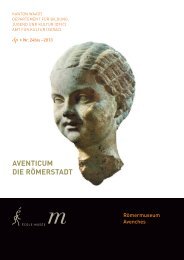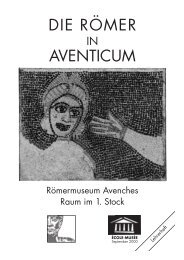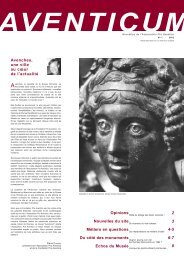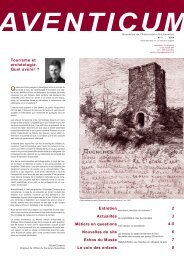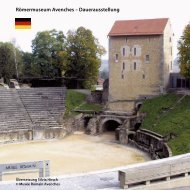Avenches – Roman Museum – Permanent Exhibition
Avenches – Roman Museum – Permanent Exhibition
Avenches – Roman Museum – Permanent Exhibition
Create successful ePaper yourself
Turn your PDF publications into a flip-book with our unique Google optimized e-Paper software.
Second Floor Clothes and Jewellery<br />
Clothes and Jewellery<br />
(Display case 2)<br />
Just like today, the inhabitants of <strong>Roman</strong> Switzerland adapted their clothes and<br />
shoes to the season, the region and to types of activities as well as their social<br />
environment.<br />
The basic outfit was the tunic, which was worn by men, women and children.<br />
The length of this T-shaped garment could vary; it consisted of two rectangular<br />
pieces of cloth, which covered the body and it had either long or short sleeves.<br />
Clothes were mainly made of linen or wool; leather or fur coats were also worn.<br />
Women’s tunics reached down to the ankles, while young girls and servants wore<br />
them down to their calves. To protect themselves against the cold they wore a cloak<br />
or a shawl and woollen stockings.<br />
Some women held on to traditional Celtic clothing: a dress was worn over a<br />
shirt-like undergarment and held together at the shoulders by fibulae.<br />
Men’s tunics were shorter and stopped at the knee or just below. To protect<br />
themselves against bad weather they had different types of cloaks made of wool<br />
such as the cucullus, a type of short cape with a hood. They protected their legs by<br />
wrapping them in puttees. The toga, a long draped cloth, was reserved for <strong>Roman</strong><br />
citizens; it was used in town during official ceremonies. Craftsmen mainly wore<br />
a short sleeveless tunic, sown together only at the left shoulder so that the arms<br />
could move freely; it was held together with a belt. Children’s tunics reached down<br />
to their knees.<br />
The shoes, made of leather, were open or closed; they could be quite high or<br />
were combined with gaiters. Some shoe soles were studded with hobnails.<br />
Men, women and children liked to wear jewellery, most of which was made of<br />
bronze or gold coloured brass. However, jewellery could also be made of iron, glass,<br />
bone or <strong>–</strong> less frequently <strong>–</strong> silver or gold and it could be decorated with precious<br />
stones.<br />
Fibulae were widely used. They are a type of brooch of Celtic origin, and were<br />
used to pin clothes together at the shoulders and to fasten coats. When sewing<br />
clothes together became more common, the fibulae took on a purely decorative<br />
function (1). Since their shapes evolved during the course of time, fibulae can be<br />
dated rather precisely and represent precious chronological evidence.<br />
The inhabitants of <strong>Roman</strong> Switzerland were fond of beads and pendants.<br />
The latter were not only adornments but may sometimes also have had a special<br />
function as talismans (nos. 98-101). Rings were usually worn on the left hand; rings<br />
with intaglios were used for sealing documents and others were a token of love<br />
(nos. 114-116). Women liked to wear necklaces and bracelets, often in pairs. Unlike<br />
Mediterranean fashion, earrings only became popular from the 3rd century AD<br />
onwards. Hairpins were generally made of bone and held together women’s hair.<br />
1<br />
46<br />
Second Floor<br />
2



